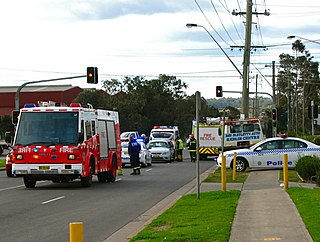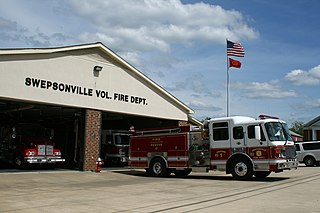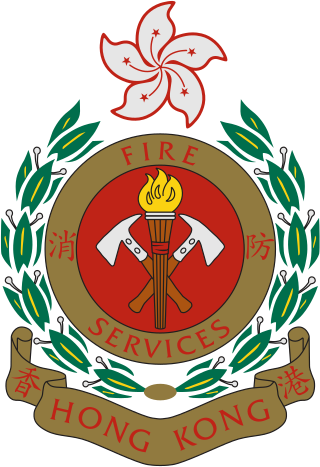
Emergency services and rescue services are organizations that ensure public safety, security, and health by addressing and resolving different emergencies. Some of these agencies exist solely for addressing certain types of emergencies, while others deal with ad hoc emergencies as part of their normal responsibilities. Many of these agencies engage in community awareness and prevention programs to help the public avoid, detect, and report emergencies effectively. Emergency services are often considered first responders, and typically have dedicated emergency vehicles.

The New York City Fire Department, officially the Fire Department of the City of New York (FDNY) is the full-service fire department of New York City, serving all five boroughs. The FDNY is responsible for fire suppression and fire prevention, and is a major provider of EMS services in New York City. Beyond fire suppression and EMS, the FDNY is responsible for a broad range of services, including technical rescue, CBRN defense, and structural collapse response and analysis. The FDNY is equipped with a wide variety of general-purpose and specialized Vehicles,Tools and Equipment to serve its varied missions.

A volunteer fire department (VFD) is a fire department of volunteers who perform fire suppression and other related emergency services for a local jurisdiction. Volunteer and retained (on-call) firefighters are expected to be on call to respond to emergency calls for long periods of time, and are summoned to the fire station when their services are needed. They are also expected to attend other non-emergency duties as well.
Firefighting jargon includes a diverse lexicon of both common and idiosyncratic terms. One problem that exists in trying to create a list such as this is that much of the terminology used by a particular department is specifically defined in their particular standing operating procedures, such that two departments may have completely different terms for the same thing. For example, depending on whom one asks, a safety team may be referred to as a standby, a RIT or RIG or RIC, or a FAST. Furthermore, a department may change a definition within its SOP, such that one year it may be RIT, and the next RIG or RIC.

The Hong Kong Fire Services Department is an emergency service responsible for firefighting and rescue on land and sea. It also provides an emergency ambulance service for the sick and the injured and gives fire protection advice to the public. It is under the Secretary for Security who heads the Security Bureau.

The Singapore Civil Defence Force (SCDF) is a uniformed organisation in Singapore under the Ministry of Home Affairs that provides emergency services such as firefighting, technical rescue, and emergency medical services, and coordinates national civil defence programme.

Mississauga Fire and Emergency Services (MFES) provides fire protection, technical rescue services, hazardous materials response, and first responder emergency medical assistance to the city of Mississauga, Ontario, Canada.
The New Zealand Fire Service was New Zealand's main firefighting body from 1 April 1976 until 1 July 2017 – at which point it was dissolved and incorporated into the new Fire and Emergency New Zealand.

A rescue vehicle is a specialised vehicle designed to transport and provide the equipment necessary for technical rescue. Vehicles carry an array of special equipment such as the jaws of life, wooden cribbing, generators, winches, hi-lift jacks, cranes, cutting torches, circular saws and other forms of heavy equipment unavailable on standard trucks. This capability differentiates them from traditional pumper trucks or ladder trucks designed primarily to carry firefighters and their entry gear as well as on-board water tanks, hoses and equipment for fire extinguishing and light rescue. Most rescue vehicles lack on-board water tanks and pumping gear, owing to their specialized role. A rescue vehicle is typically operated by a rescue squad, but in some areas it may be integrated with emergency medical services or fire departments.

NSW Ambulance, previously the Ambulance Service of NSW, is an agency of NSW Health and the statutory provider of pre-hospital emergency care and ambulance services in the state of New South Wales, Australia.
As firefighting has a rich history throughout the world, traditions in this profession vary widely from country to country.
The New Jersey Transit Police Department (NJTPD) is a transit police agency of the New Jersey Transit Corporation in the state of New Jersey. As provided by NJS Title 27:25-15.1, New Jersey Transit Police Officers have "general authority, without limitation, to exercise police powers and duties, as provided by law for police officers and law enforcement officers, in all criminal and traffic matters at all times throughout the State and, in addition, to enforce such rules and regulations as the NJ Transit Corporation shall adopt and deem appropriate."

The Emergency Service Unit(ESU) is part of the Special Operations Bureau of the New York City Police Department. The unit provides specialized support and advanced equipment to other NYPD units. Members of ESU are cross-trained in multiple disciplines for police, medical, and rescue work.

Firefighting in the United States dates back to the earliest European colonies in the Americas. Early firefighters were simply community members who would respond to neighborhood fires with buckets. The first dedicated volunteer fire brigade was established in 1736 in Philadelphia. These volunteer companies were often paid by insurance companies in return for protecting their clients.

The Baltimore City Fire Department (BCFD) provides fire protection and emergency medical services to the city of Baltimore, Maryland, United States. Founded in 1797 and established in 1859, the Baltimore City Fire Department covers an area of 81 square miles (210 km2) of land and 11 square miles (28 km2) of water, with a resident population of over 640,000 and a daytime population of over 1,000,000. The BCFD responds to approximately 235,000 emergency calls annually. There are two International Association of Fire Fighters (IAFF) locals; IAFF 734 for firefighters and IAFF 964 for officers.

A hazardous material (hazmat) apparatus is a vehicle used by emergency services to respond to calls involving potentially hazardous materials. These vehicles are customized to fit the needs of the agency responsible for the apparatus, which may be a rescue squad, fire department, emergency medical services, law enforcement agency, or military.

The Vancouver Fire Department (VFD) provides fire protection and emergency medical services to the city of Vancouver and, by contract to Clark County Fire District 5, in Washington, United States. The VFD's response area is 91 square miles (240 km2) with a population of over 294,000 (2023). The VFD has the highest call volume per firefighter in the state. ALS transport is provided by AMR, making the VFD's service area population by far the largest in Western Washington without public ALS ambulance service.

Harrisburg Bureau of Fire (HBF) is a firefighting agency that is located in and serves Harrisburg, Pennsylvania, and its surrounding metropolitan area. It is a career firefighting agency with at least 15 firefighters and fire officers on duty at any given time, supplemented with volunteer staffing as well. Everyday duties for the Bureau include fire suppression, emergency medical services, tactical rescue, urban search and rescue, water rescue, hazardous materials response, fire prevention, fire codes enforcement, and public safety educations.

The Pittsburgh Bureau of Emergency Medical Services (PEMS) provides emergency medical services and medically directed rescue services for the City of Pittsburgh, Pennsylvania. It is a bureau of the Department of Public Safety (DPS), along with the Bureaus of Police, Administration, Fire, and Animal Care and Control. The department is responsible for 55.5 square miles (144 km2) with a population of 305,841 as of the 2013 Census estimation. The Bureau was founded in 1975 by the then current city administration, absorbing Freedom House Ambulance. In addition, the Bureau of EMS was one of the first EMS agencies in the world.
A Special operations firefighter, also known as Fire Service Special Operations, is a specialist firefighter who has been specially trained to execute tasks other than standard firefighting operations. The National Fire Protection Association's Standard for the Organization and Deployment of Fire Suppression Operations, Emergency Medical Operations, and Special Operations to the Public by Career Fire Departments defines special operations as "Those emergency incidents to which the fire department responds that require specific and advanced training and specialized tools and equipment". The NFPA 1710 further defined special operations as "Special operations include water rescue, extrication, hazardous materials, confined space entry, highangle rescue, aircraft rescue and fire fighting, and other operations requiring specialized training".














